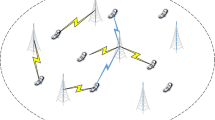Abstract
Millimeter-Wave (mmWave) communication in ultra-dense networks (UDNs) has been considered as a promising technology for future wireless communication systems. Exploiting the benefits of mmWave and UDNs, we introduce a new approach for jointly optimizing small-cell base station (SBS) - user (UE) association and power allocation to maximize the system energy efficiency (EE) while guaranteeing the quality of service (QoS) constraints for each UE. The SBS-UE association problem poses a new challenge since it reflects as a complex mixed-integer non-convex problem. On the other hand, the power allocation problem is in non-convexity structure, which is impossible to handle with the association problem concurrently. An alternating descent method is thus introduced to divide the primal optimization problem into two subproblems and handle one-by-one at each iteration, where the SBS-UE association problem is reformulated using the penalty approach. Then, path-following algorithms are developed to convert non-convex problem into the simple convex quadratic functions at each iteration. Numerical results are provided to demonstrate the convergence and low-complexity of our proposed schemes.
This research was supported by the MSIT (Ministry of Science and ICT), Korea, under the Grand Information Technology Research Center support program (IITP-2018-2016-0-00318) supervised by the IITP (Institute for Information & communications Technology Promotion).
Access this chapter
Tax calculation will be finalised at checkout
Purchases are for personal use only
Similar content being viewed by others
Notes
- 1.
The term “micro-cell operator” is used to indicate the deployment of micro-cell base stations at the private areas like school zones, factories, company buildings with their individual policies [5].
References
Bai, T., Heath, R.W.: Coverage and rate analysis for millimeter-wave cellular networks. IEEE Trans. Wirel. Commun. 14(2), 1100–1114 (2015)
Che, E., Tuan, H.D., Nguyen, H.H.: Joint optimization of cooperative beamforming and relay assignment in multi-user wireless relay networks. IEEE Trans. Wirel. Commun. 13(10), 5481–5495 (2014)
Chen, S., Qin, F., Hu, B., Li, X., Chen, Z.: User-centric ultra-dense networks for 5G: challenges, methodologies, and directions. IEEE Wirel. Commun. 23(2), 78–85 (2016)
Gao, Z., Dai, L., Mi, D., Wang, Z., Imran, M.A., Shakir, M.Z.: MmWave massive-MIMO-based wireless backhaul for the 5G ultra-dense network. IEEE Wirel. Commun. 22(5), 13–21 (2015)
Ishizu, K., Murakami, H., Ibuka, K., Kojima, F.: Next generation mobile communications system to realize flexible architecture and spectrum sharing. J. NICT 64(2), 3–12 (2017)
Khan, F., Pi, Z.: mmWave mobile broadband (MMB): unleashing the 3–300GHz spectrum. In: 2011 34th IEEE Sarnoff Symposium, pp. 1–6, May 2011
Koivisto, M., Hakkarainen, A., Costa, M., Kela, P., Leppanen, K., Valkama, M.: High-efficiency device positioning and location-aware communications in dense 5G networks. IEEE Commun. Mag. 55(8), 188–195 (2017)
Liu, P., Di Renzo, M., Springer, A.: Line-of-sight spatial modulation for indoor mmWave communication at 60 GHz. IEEE Trans. Wirel. Commun. 15(11), 7373–7389 (2016)
Nguyen, L.D., Tuan, H.D., Duong, T.Q.: Energy-efficient signalling in QoS constrained heterogeneous networks. IEEE Access 4, 7958–7966 (2016)
Nguyen, V.D., Duong, T.Q., Tuan, H.D., Shin, O.S., Poor, H.V.: Spectral and energy efficiencies in full-duplex wireless information and power transfer. IEEE Trans. Commun. 65(5), 2220–2233 (2017)
Pi, Z., Choi, J., Heath, R.: Millimeter-wave gigabit broadband evolution toward 5G: fixed access and backhaul. IEEE Commun. Mag. 54(4), 138–144 (2016)
Sheng, Z., Tuan, H.D., Nasir, A.A., Duong, T.Q., Poor, H.V.: Power allocation for energy efficiency and secrecy of wireless interference networks. IEEE Trans. Wirel. Commun. PP(99), 1–2 (2018)
Sheng, Z., Tuan, H.D., Duong, T.Q., Poor, H.V.: Joint power allocation and beamforming for energy-efficient two-way multi-relay communications. IEEE Trans. Wirel. Commun. 16(10), 6660–6671 (2017)
Stephen, R.G., Zhang, R.: Joint millimeter-wave fronthaul and OFDMA resource allocation in ultra-dense CRAN. IEEE Trans. Commun. 65(3), 1411–1423 (2017)
Tam, H.H.M., Tuan, H.D., Ngo, D.T., Duong, T.Q., Poor, H.V.: Joint load balancing and interference management for small-cell heterogeneous networks with limited backhaul capacity. IEEE Trans. Wirel. Commun. 16(2), 872–884 (2017)
Tuy, H.: Convex Analysis and Global Optimization. Springer, Heidelberg (2017). https://doi.org/10.1007/978-3-319-31484-6
Wang, P., Li, Y., Song, L., Vucetic, B.: Multi-gigabit millimeter wave wireless communications for 5G: From fixed access to cellular networks. IEEE Commun. Mag. 53(1), 168–178 (2015)
Xu, Y., Shokri-Ghadikolaei, H., Fischione, C.: Distrubuted association and relaying with fairness in millimeter wave networks. IEEE Trans. Wirel. Commun. 5(12), 7955–7970 (2016)
Yang, G., Du, J., Xiao, M.: Maximum throughput path selection with random blockage for indoor 60 GHz relay networks. IEEE Trans. Commun. 63(10), 3511–3524 (2015)
Zhang, H., Huang, S., Jiang, C., Long, K., Leung, V.C., Poor, H.V.: Energy efficient user association and power allocation in millimeter-wave-based ultra dense networks with energy harvesting base stations. IEEE J. Sel. Areas Commun. 35(9), 1936–1947 (2017)
Author information
Authors and Affiliations
Corresponding author
Editor information
Editors and Affiliations
Appendix: Fundamental Inequalities
Appendix: Fundamental Inequalities
As the function \(f(x,y)\triangleq \ln (1+1/xy)\) is convex in the domain \(\{x>0, y>0\}\) [12], it follows that [16] for every \(x>0\), \(y>0\), \(\bar{x}>0\) and \(\bar{y}>0\),
Reutilizing inequalities in [15], we observe that function \(x^2/t\) is always convex under condition of \(x > 0\) and \(t > 0\), which yields inequality
Then substituting \(x \rightarrow \sqrt{x}\) and \(\bar{x} \rightarrow \sqrt{\bar{x}}\), we obtain
Lastly, the inequality
always hold true since \(x^2 - x\) is in convex quadratic form [15].
Rights and permissions
Copyright information
© 2019 ICST Institute for Computer Sciences, Social Informatics and Telecommunications Engineering
About this paper
Cite this paper
Nguyen, H.T. et al. (2019). Energy Efficiency in QoS Constrained 60 GHz Millimeter-Wave Ultra-Dense Networks. In: Duong, T., Vo, NS., Phan, V. (eds) Quality, Reliability, Security and Robustness in Heterogeneous Systems. Qshine 2018. Lecture Notes of the Institute for Computer Sciences, Social Informatics and Telecommunications Engineering, vol 272. Springer, Cham. https://doi.org/10.1007/978-3-030-14413-5_7
Download citation
DOI: https://doi.org/10.1007/978-3-030-14413-5_7
Published:
Publisher Name: Springer, Cham
Print ISBN: 978-3-030-14412-8
Online ISBN: 978-3-030-14413-5
eBook Packages: Computer ScienceComputer Science (R0)




